 W
WWrestling is a combat sport involving grappling-type techniques such as clinch fighting, throws and takedowns, joint locks, pins and other grappling holds. The sport can either be genuinely competitive or sportive entertainment. Wrestling comes in different types such as folkstyle, freestyle, Greco-Roman, catch, submission, judo, sambo and others. A wrestling bout is a physical competition, between two competitors or sparring partners, who attempt to gain and maintain a superior position. There are a wide range of styles with varying rules with both traditional historic and modern styles. Wrestling techniques have been incorporated into other martial arts as well as military hand-to-hand combat systems.
 W
WArm triangle choke, side choke, or head and arm choke are generic terms describing blood chokeholds in which the opponent is strangled in between their own shoulder and the practitioner's arm. This is as opposed to the regular triangle choke, which denotes a chokehold using the legs, albeit with a similar mechanism of strangulation against the opponent's own shoulder. An arm triangle choke where the practitioner is on the side of the opponent and presses a forearm into the opposite side of the neck of the opponent is known as a side choke, such as from the kata-gatame hold.
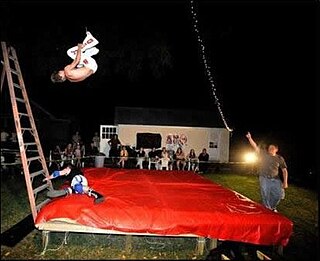 W
WBackyard wrestling (BYW), also referred to as yarding or backyarding, is a form of professional-style wrestling, typically in a low-budget environment, such as a backyard. Although not legitimized, backyard wrestling is often organized into federations. Most backyard wrestlers are merely emulating modern wrestling, though a small percentage have experience from enrolling in wrestling school or from referring to how-to guides on the web.
 W
WIn wrestling, a bear hug, also known as a bodylock, is a grappling clinch hold and stand-up grappling position where the arms are wrapped around the opponent, either around the opponent's chest, midsection, or thighs, sometimes with one or both of the opponent's arms pinned to the opponent's body. The hands are locked around the opponent and the opponent is held tightly to the chest. The bear hug is a dominant position, with great control over the opponent, and also allows an easy takedown to the back mount position.
 W
WBelt wrestling is a form of wrestling that is one of the oldest historically recorded sports. It involves two belted contestants aiming to take each other over by grappling with a belt. There are hundreds national belt wrestling styles, but contemporary most widespread and internationally competed are Alysh and Kurash, developed by the previously nomadic Turkic peoples of Central Asia. United World Wrestling recognized Alysh wrestling as the primary international belt wrestling style. It is regulated globally by the International Federation of Wrestling on Belts Alysh, the sport's governing body. Although the sport has been practiced for millennia, and local championships were held in various places of the world, it was until 2001 when Bayaman Erkinbayev started its international version, and it was called "Alysh". Until 2005, Rif Gaynanov and Bayaman Erkinbayev developed this style together, and then the ways separated. Two different styles appeared named "Alysh" and "Kurash" belt wrestling. Since then, the sport has been included in the 2013 Summer Universiade program, recognized by the Asian Olympic Council, and contested at the Asian Games and Asian Indoor Games. The sport's executives struggle to promote it to the level of an official Olympic sport.
 W
WThe bridge is a grappling move performed from a supine position, lying down face-up. It involves lifting the pelvis off the ground so that the body weight is supported on the shoulders at one end and on the feet at the other. This move is used in wrestling and other grappling and groundfighting sports, often combined with a twisting motion, to dislodge or flip an opponent who has established a position on top. The bridge is also a common exercise position. This maneuver can also be used to dodge pin attempts.
 W
WCauliflower ear is an irreversible condition that occurs when the external portion of the ear is hit and develops a blood clot or other collection of fluid under the perichondrium. This separates the cartilage from the overlying perichondrium that supplies its nutrients, causing it to die and resulting in the formation of fibrous tissue in the overlying skin. As a result, the outer ear becomes permanently swollen and deformed, resembling a cauliflower.
 W
WCollar tie is a grappling clinch hold that is used to control the opponent. It is performed from the front of the opponent by grabbing the opponent by the collar, behind the neck, or behind the trapezius muscle. A collar tie using one hand is called a single collar tie, and a collar tie with both hands is called a double collar tie.
 W
WA collar-and-elbow hold is a stand-up grappling position where both combatants have a collar tie, and hold the opponent's other arm at the elbow. Generally the opening move in professional wrestling, the collar-and-elbow is generally a neutral position, but by pushing the hand on the elbow to the inside of the opponent's arms, and holding the biceps, more control can be obtained. From here it will be easier to strike or to attempt takedowns, while defending against the opponent's techniques.
 W
WThe crucifix position is a ground grappling position that involves being perpendicularly behind the opponent, chest against back, and controlling the opponent's arms. One of the opponent's arms is controlled using the legs, and the other using the arms, hence effectively putting the opponent in a position resembling a crucifix. This position allows for elbow strikes to the head, or if the opponent is wearing a gi, it allows for a collar strangle called the crucifix choke. It is also possible to have the crucifix position in such a way that a crucifix neck crank can be applied.
 W
WA figure-four is a Catch wrestling term for a joint-lock that resembles the number "4". A keylock or toe hold can be referred to as a figure-four hold, when it involves a figure-four formation with the legs or arms. If the figure-four involves grabbing the wrists with both hands, it is called a double wrist lock; known as kimura in MMA circles. A figure-four hold done with the legs around the neck and (usually) arm of an opponent is called figure-four (leg-)choke, better known as a triangle choke these days, and is a common submission in modern mixed martial arts, Submission wrestling and Brazilian jiu jitsu, and of course Catch wrestling. In addition to Lancashire, or catch-as-catch-can wrestling, the move was also found in Japanese jiu-jitsu, and was thereafter incorporated into Judo. The leg figure-four choke is also part of Japanese martial arts, where it is known as Sankaku-Jime.
 W
WThe National Wrestling Hall of Fame and Museum is a museum and hall of fame for amateur wrestling, headquartered in Stillwater, Oklahoma. In 2010, it began operating the Dan Gable Museum in Waterloo, Iowa.
 W
WFinal X is an annual series of amateur wrestling events that determine the Senior World Team of Team USA.
 W
WA grappling hold, commonly referred to simply as a hold that in Japanese is referred to as katame-waza, is any specific grappling, wrestling, judo, or other martial art grip that is applied to an opponent. Grappling holds are used principally to control the opponent and to advance in points or positioning. The holds may be categorized by their function, such as clinching, pinning, or submission, while others can be classified by their anatomical effect: chokehold, headlock, joint-lock, or compression lock. Multiple categories may be appropriate for some of these holds.
 W
WWrestling and grappling sports have a long and complicated history, stretching into prehistoric times. Many traditional forms survive, grouped under the term folk wrestling. More formal systems have been codified in various forms of martial arts worldwide, where grappling techniques form a significant subset of unarmed fighting.
 W
WThe ippon seoi nage (一本背負投) is a throw in judo. It is a variant of Seoi nage, and is one of the nineteen accepted techniques in Shinmeisho No Waza of Kodokan Judo. It is classified as a hand throwing technique, or te-waza.
 W
WJacket wrestling is a form of combat that has been practiced in both Europe and Asia going back many centuries. The style of combat is typified by a lack of groundfighting, due to the rules often causing an opponent to lose if they touch the ground with something other than their feet. It has been recorded as a method of combat as early as the Middle Ages. Jacket wrestling became especially popular in England, where different regions developed their own forms of jacket wrestling rules and combat. The method of combat has also been referred to as "belt-and-jacket wrestling", for its common use of a belt or sash in addition to or instead of a jacket.
 W
WDaniel Magnus is an American martial artist, athletic trainer, celebrity bodyguard, fugitive recovery specialist and businessman. He is a two-time world kickboxing champion and is best known for being the only person to ever defend his championship title after open-heart surgery. He is an 8th-degree Black Belt and has owned and operated five Martial Arts schools. He is a veteran of WWE and WCW and also started his own professional wrestling promotion, Central Wrestling Organization, in Denver, Colorado.
 W
WA nelson hold is a grappling hold which is executed by one person from behind the opponent, generally when both are on the mat face down with the opponent under the aggressor. One or both arms are used to encircle the opponent's arm under the armpit, and secured at the opponent's neck. Several different nelson holds exist, and they can be separated according to the positioning of the encircling arm(s). A nelson is used to control an opponent or to turn them over onto their back and execute a pin.
 W
WOver–under is a stand-up grappling position in which both combatants have one overhook and one underhook, and is the most common stand-up grappling position in mixed martial arts. The head is typically on the same side as the overhooked arm, to allow greater weight to be put on the opponent's underhooked arm, and hence preventing the opponent from using the underhooked arm effectively. The over–under position can be advanced into a pinch grip tie by locking the hands behind the opponent's back.
 W
WIn wrestling, an overhook, also called a whizzer, is a clinch hold that is used to control the opponent. An overhook is performed from any direction by putting an arm over the opponent's arm, and encircling the opponent's arm or upper body. Having an overhook with one arm is called a single overhook, while having overhooks with both arms is known as double overhooks. Overhooks are typically employed in response to underhooks by an opponent.
 W
WA pin, or fall, is a victory condition in various forms of wrestling that is met by holding an opponent's shoulders or scapulae on the wrestling mat for a prescribed period of time. This article deals with the pin as it is defined in amateur wrestling.
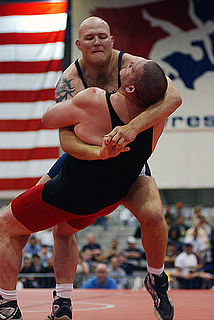 W
WA pinch grip tie, or an over-under bodylock, is a clinch hold and stand-up grappling position that is an extension of the over-under position, but having both hands locked behind the opponents back. The hands are typically locked with a palm-to-palm grip, palm-to-wrist grip or fingers-to-fingers grip. The pinch grip tie can be used to throw the opponent, but usually the grapplers attempt to obtain a better hold such as double underhooks or double collar tie. The pinch grip tie is often a neutral position when both grapplers symmetrically have the same hold on each other.
 W
WRepechage is a practice in series competitions that allows participants who failed to meet qualifying standards by a small margin to continue to the next round. A well known example is the wild card system.
 W
WSock wrestling is a game that can be played by children, teenagers and young adults, with at least two people, and consists of taking one or both of your opponent's sock off their foot to win.
 W
WThe spladle is a wrestling technique commonly used as a counter and pinning move to single leg take downs. When opponents shoot in and grab the leg the wrestler will drop their weight on the opponents head to prevent advancement of the take down, from there they may reach across the body with their arms to grab hold of the opponents far side leg, once completed they wrap the near side leg with the leg targeted for the take down and roll forward onto the mat. When on the floor it is important to control both legs of the opponent as the wrestler wants to bring the knees of his opponent as close to inline with the opponents head as possible.
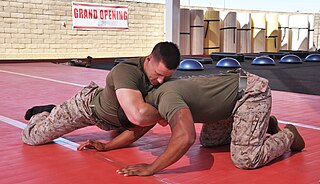 W
WA sprawl is a martial arts and wrestling term for a defensive technique that is done in response to certain takedown attempts, typically double or single leg takedown attempts. The sprawl is performed by scooting the legs backwards, so as to land on the upper back of the opponent attempting the takedown. The resultant position is also known as a sprawl or sprawling position.
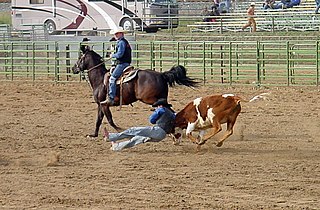 W
WSteer wrestling, also known as bulldogging, is a rodeo event in which a horse-mounted rider chases a steer, drops from the horse to the steer, then wrestles the steer to the ground by grabbing its horns and pulling it off-balance so that it falls to the ground. The event carries a high risk of injury to the cowboy. There are some concerns from the animal rights community that the competition may include practices that constitute cruelty to animals, but the injury rate to animals is less than five-hundredths of one percent. A later PRCA survey of 60,971 animal performances at 198 rodeo performances and 73 sections of "slack" indicated 27 animals were injured, again approximately five-hundredths of 1 percent – 0.0004.
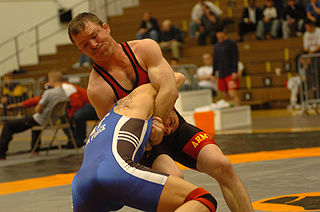 W
WThe various styles of wrestling include:amateur sports professional sports, and sports entertainments
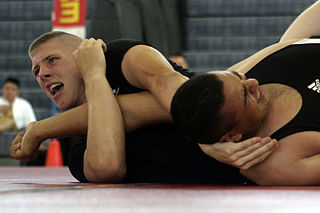 W
WSubmission Wrestling, also known as Submission Fighting, Submission grappling, Sport grappling, or Combat wrestling, is a form of competition and a general term for martial arts and combat sports that focus on clinch and ground fighting with the aim of obtaining a submission through the use of submission holds. The term "submission wrestling" usually refers only to the form of competition and training that does not use a gi, or "combat kimono", of the sort often worn with belts that establish rank by color, though some may use the loose trousers of such a uniform, without the jacket. Not using a gi has a major impact on the sport : there are many choke techniques which make use of the lapels of the gi, thus rendering them un-usable and grappling in general becomes more difficult when the opponent doesn't have a gi to grab hold of.
 W
WIn martial arts and combat sports, a takedown is a technique that involves off-balancing an opponent and bringing him or her to the ground with the attacker landing on top. The process of quickly advancing on an opponent and attempting a takedown is known as shooting for a takedown, or simply shooting. Takedowns are usually distinguished from throws by amplitude and impact, with throws being a subset of takedown. Takedowns are featured in all forms of wrestling and stand-up grappling.
 W
WA transition in grappling is a move from one grappling hold or grappling position to another. The process is called transitioning and is one of the most important aspects of ground grappling, as it allows the combatant performing the transition to advance in positioning, for instance by using a sweep, or to attempt pinning holds or submission holds.
 W
WAn underhook is a clinch hold that is used in grappling to control the opponent. It is performed from any direction by putting an arm under the opponent's arm, and holding the opponent's midsection or upper body. Having an underhook with one arm is called a single underhook, while having underhooks with both arms is known as double underhooks. The typical response to an underhook is to try to break it, or to establish an overhook.
 W
W